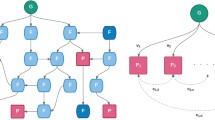Abstract
Large numbers of sibling pairs or other relatives are needed to detect linkage between a quantitative trait locus (QTL) and a marker, especially if the variance of the QTL is low relative to the total phenotypic variance of the trait. One strategy to increase the power to detect linkage is to reduce the environmental variance in the trait under analysis. This approach was explored by carrying out a series of simulation studies in which multivariate observations were used to estimate individual genotypic values at a QTL, that pleiotropically affected more than one trait. Simulations for different QTL allele frequencies with a completely informative marker showed that the power to detect the QTL increased substantially when estimates of individual genotypic values at the QTL were used in the linkage analysis instead of phenotypic observations. An advantage of this approach is that, rather than employing phenotypic selection, individuals with extreme genotypes may be selected when ascertaining a sample of extreme families.
Similar content being viewed by others
References
Amos, C. I., and Elston, R. C. (1989). Robust methods for the detection of genetic linkage for quantitative data from pedigrees.Genet. Epidemiol. 6:349–360.
Amos, C. I., Elston, R. C., Bonney, G. E., Keats, B. J. B., and Berenson, G. S. (1990). A multivariate method for detecting genetic linkage, with application to a pedigree with an adverse lipoprotein phenotype.Am. J. Hum. Genet. 47:247–254.
Blackwelder, W. C., and Elston, R. C. (1982). Power and robustness of sib-pair linkage tests and extension to larger sibships.Comm. Stat. Theory Meth. 11:449–484.
Boomsma, D. I., and Molenaar, P. C. M. (1986). Using LIS-REL to analyze genetic and environmental covariance structure.Behav. Genet. 16:237–250.
Boomsma, D. I., Molenaar, P. C. M., and Orlebeke, J. F. (1990). Estimation of individual genetic and environmental factor scores.Genet. Epidemiol. 7:83–91.
Boomsma, D. I., Molenaar, P. C. M., and Dolan, C. V. (1991). Estimation of individual genetic and environmental profiles in longitudinal designs.Behav. Genet. 21:241–253.
Cardon, L. R., and Fulker, D. W. (1994). The power of interval mapping of quantitative trait loci using selected sib pairs.Am. J. Hum. Genet. 55:825–833.
Carey, G., and Williamson, J. (1991). Linkage analysis of quantitative traits: Increased power by using selected samples.Am. J. Hum. Genet. 49:786–796.
Eaves, L., and Meyer, J. (1994). Locating human quantitative trait loci: Guidelines for the selection of sibling pairs for genotyping.Behav. Genet. 24:443–455.
Fulker, D. W., and Cardon, L. R. (1994). A sib-pair approach to interval mapping of quantitative trait loci.Am. J. Hum. Genet. 54:1092–1103.
Fulker, D. W., Cherney, S. S., and Cardon, L. R. (1995). Multipoint interval mapping of quantitative trait loci, using sib pairs.Am. J. Hum. Genet. 56:1224–1233.
Goldgar, D. E. (1990). Multipoint analysis of human quantitative genetic variation.Am. J. Hum. Genet. 47:957–967.
Haseman, J. K., and Elston, R. C. (1972). The investigation of linkage between a quantitative trait and a marker locus.Behav. Genet. 2:3–19.
Kruglyak, L., and Lander, E. (1995). Complete multipoint sib pair analysis of qualitative and quantitative traits.Am. J. Hum. Genet. 57:439–454.
Lawley, D. N., and Maxwell, A. E. (1971).Factor Analysis as a Statistical Method. Butterworths, London.
Martin, N. G., and Eaves, L. J. (1977). The genetical analysis of covariance structure.Heredity 38:79–95.
Mulaik, S. A. (1972).The Foundations of Factor Analysis, McGraw-Hill, New York.
Penrose, G. S. (1983). Genetic linkage in graded human characters.Ann. Eugen. 8:223–237.
Risch, N., and Zhang, H. (1995). Extreme discordant sib pairs for mapping quantitative trait loci in humans.Science 268:1584–1589.
Saris, W. E., De Pijper, M., and Mulder, J. (1978). Optimal procedures for estimation of factor scores.Sociol. Methods Res. 7:85–106.
Schork, N. J. (1993). Extended multipoint identity-by-descent analysis of human quantitative traits: Efficiency, power, and modeling considerations.Am. J. Hum. Genet. 53:1306–1319.
Author information
Authors and Affiliations
Rights and permissions
About this article
Cite this article
Boomsma, D.I. Using multivariate genetic modeling to detect pleiotropic quantitative trait loci. Behav Genet 26, 161–166 (1996). https://doi.org/10.1007/BF02359893
Received:
Accepted:
Issue Date:
DOI: https://doi.org/10.1007/BF02359893




